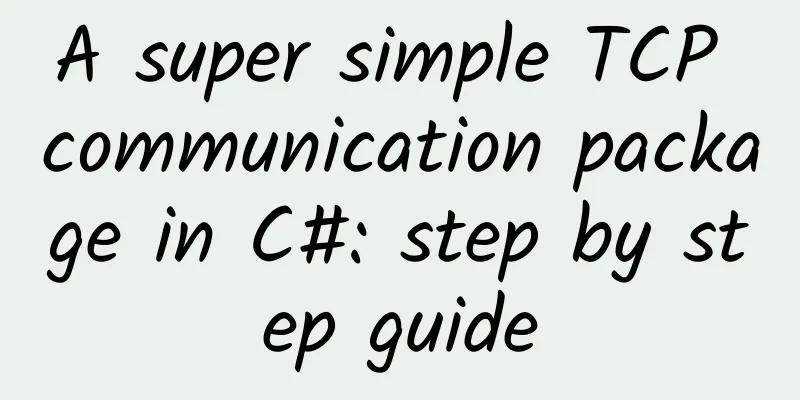A super simple TCP communication package in C#: step by step guide

|
Hey, fellow developers! Today we are going to talk about TCP communication in C#. TCP (Transmission Control Protocol) is a connection-oriented, reliable, byte-stream-based transport layer communication protocol. In many application scenarios, we need to use TCP to achieve data transmission between the client and the server. Don't worry, even if you are a novice in TCP communication, I will use the simplest and most colloquial way to take you step by step to implement a basic TCP communication package. 1. PreparationBefore you begin, make sure you have installed Visual Studio (or another IDE that supports C#) in your development environment and created a new C# console project. 2. Create a serverFirst, let's implement a simple TCP server. This server will listen on a specific port, wait for client connections, and return a response after receiving a message.
3. Create a clientNext, we will implement a simple TCP client that will connect to the server, send a message, and receive a response from the server.
4. Run the testNow that you have completed the server and client code, let's run it and see the effect.
V. ConclusionThrough the above steps, you have successfully implemented a simple TCP communication package. The server will listen to a port, wait for the client to connect, and return a response after receiving the message. The client will connect to the server, send a message, and receive the server's response. This is just a basic implementation, you can expand and optimize it, such as adding multi-threading support, exception handling, data format processing, etc. I hope this article is helpful to you, and I wish you happy programming! |
<<: What you need to know about HTTP protocol
Recommend
Why choose NB-IoT when there are so many standards?
The need for communication is indispensable in ou...
5G will catalyze the era of large-scale innovation in the whole society
Intuitively, 5G has a very obvious role in drivin...
European countries are intensively carrying out 5G spectrum auctions: Why the cost differences are so different
Compared to Italy, Austria's 5G sales look li...
Current status of Chinese domain names: low application level and potential security risks
Recently, at the Second China Domain Name Develop...
5 Things That Can Slow Down Your Wi-Fi Network
Wi-Fi networks can be slow due to the use of olde...
Blockchain development faces four major "pain points"
Not long ago, the central bank and seven other mi...
802.11be (Wi-Fi 7) Technology Outlook
1. Overview of Wi-Fi 7 New Features Figure 1 is a...
iWebFusion dedicated server starts from $49/month, 4-40 core CPU, 384G memory, NVMe hard disk, 1-10G bandwidth, multiple computer rooms in Los Angeles and other places
iWebFusion (formerly iWFHosting) is a hosting com...
Dr. Li Jin: Is building credibility “regardless of cost”?
[51CTO.com original article] June in Beijing is w...
You clearly have a 4G phone, but the operator still wants you to sign up for a 5G package?
According to data from the China Academy of Infor...
The love-hate relationship between video surveillance networks and IPv6 in the era of the Internet of Things
Among the three major layers of the Internet of T...
Japanese media: Industry insiders say it will take several years for Japan to achieve 5G nationwide coverage
According to a report by Japan's Jiji Press o...
Megalayer Summer Promotion: VPS hosting starts at 189 yuan per year, with optional data centers in San Jose, US, Hong Kong, China, and Singapore
Megalayer's summer special offer is in progre...
H3C Launches Telecom-Grade Cloud Platform at MWC Shanghai
On June 28, H3C Group made its debut at the Asian...









